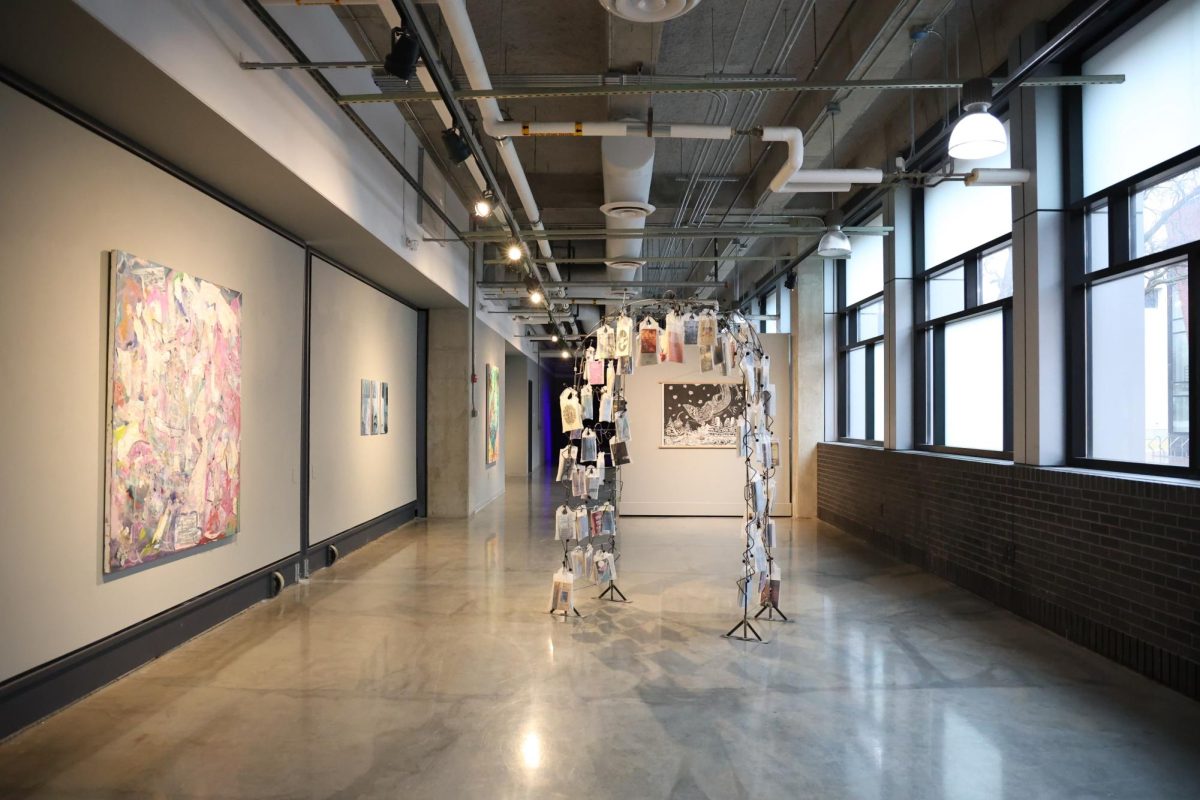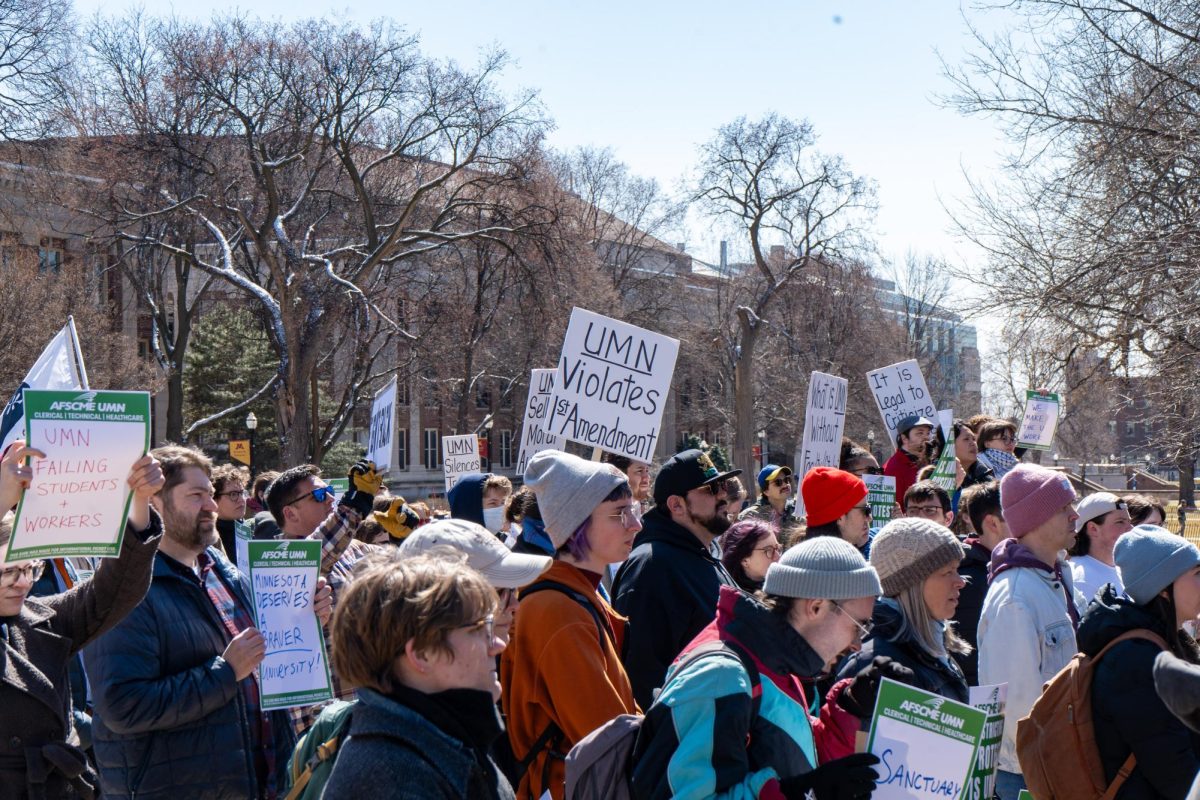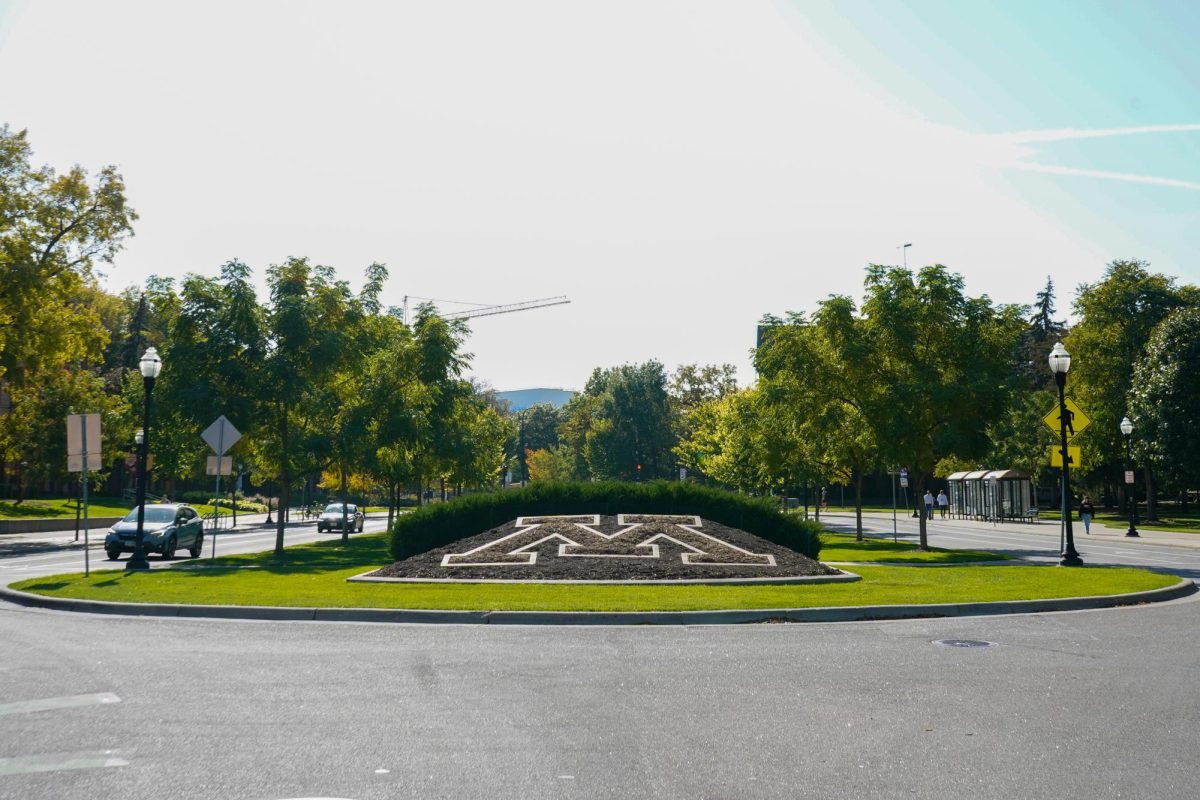Students across the University of Minnesota Twin Cities campus are full of fear and anxiety. Administrators are trying to juggle Immigration and Customs Enforcement (ICE) compliance with the safety of undocumented and immigrant students, and many say more needs to be done.
A coalition of students, staff, faculty, administrators and community members are circulating a petition to support non-citizen and immigrant community members. The nine demands include University President Rebecca Cunningham joining the Presidents’ Alliance for Higher Education and Immigration, restoring the now-defunct Immigration Response Team and ensuring UMPD does not assist ICE operations, among others.
As of Feb. 3, the petition has garnered over 3,100 signatures in four days, double the amount of signatures of the 2016 petition to make the University a sanctuary campus.
The University’s Center for Race, Indigeneity, Disability, Gender & Sexuality Studies (RIDGS) Director and Chicano Studies professor Jimmy Patino Jr. said the Faculty Senate Social Concerns Committee has agreed to write a statement requesting the administration join the alliance and follow its recommendations.
Finance and Operations Vice President Gregg Goldman said in an emailed statement Friday that the University is committed to keeping community members affected by immigration policy safe and well informed. Goldman provided links to resources and FAQs regarding resources and advice in the email.
“In my role overseeing the Department of Public Safety on the Twin Cities campus and in public safety matters systemwide, I want to reassure you that the University has personnel and resources in place to support faculty, staff, and students who may be affected by these changes,” Goldman said in the email.
Chicano and Latino Studies professor and Faculty Senator Jessica Lopez Lyman said past University presidents were very active in communicating that campus was a safe space where campus police would not aid and abet ICE. She added that a limited message sends a message.
Lopez Lyman said undocumented and immigrant students might not be safe walking the streets downtown or in their neighborhoods, but they should not have to fear ICE coming into their classes.
“One of the things the President cares a lot about, and I agree with her, is that wellness for students should be first and foremost.” Lopez Lyman said. “Right now we have had limited word from the administration, and we want to ensure that our undocumented students and students who are non-citizens feel supported on campus.”
Cunningham reaffirmed in a Feb. 3 email that campus departments of public safety do not have a role in enforcing immigration laws and added officers “do not view it as their role” to inquire about immigration status.
“Personnel and resources are in place to support international students, faculty and staff who may be affected by these federal policy changes,” Cunningham said in the email. “This webpage is a great resource for answers to frequently asked questions on this topic.”
Cunningham did not provide information regarding whether she would sign the Presidents’ Alliance on Higher Education and Immigration.
Former University presidents and petitions on ICE
This petition is not the first time University measures for federal immigration policy have been considered.
In 2017, former University president Eric Kaler expressed disappointment in President Donald Trump’s previous attempts at revoking Deferred Action for Childhood Arrivals (DACA) and told the Minnesota Daily that it “takes a human toll” on DACA students. This came after a 2016 petition to make the University a sanctuary campus garnered over 1,500 signatures, and Kaler vowed support to all members of the community.
In 2020, under former University president Joan Gabel, the University joined other universities across the nation in signing an Amicus Curiae brief in a lawsuit against ICE restrictions. The brief said ICE’s restrictions were neither safe nor educationally advisable and would have devastating effects on international students.
“We cannot stand by in good conscience as international students are forced out of the country through no fault of their own,” Gabel said in a University news release. “We stand with our international students, and international students across the country, in asking that the ICE directive be overturned immediately.”
Former University Interim President Jeff Ettinger is a current member of the President’s Alliance on Higher Education and Immigration, according to their website.
The President’s Alliance on Higher Education and Immigration is an alliance of American college and university leaders dedicated to understanding how immigration policy affects students and campuses. They say universities across America need to mobilize strategies to protect access and equity under new ICE guidelines by challenging legislation, ensuring safety and promising to stand with students.
What the University is doing
After Trump’s Jan. 20 executive order to end birthright citizenship and revocation of former President Joe Biden’s “Churches and Schools” executive order, the University said it will still comply with federal court orders when it comes to ICE requests, according to the Minnesota Daily.
This means the University will not release student immigration data, and UMPD will not be responsible for enforcement of ICE directives. However if ICE agents have official judicial warrants, they can access campus locations as well as student data.
According to Axios, schools can set policies that support students impacted by immigration enforcement, as well as train faculty and staff on how to interact with officers. What schools are not allowed to do is reveal most personal information without parental permission or a subpoena signed by a judge, Axios reported.
University of Minnesota President Rebecca Cunningham released a video Jan. 29 about the new presidential administration and how it will impact the University. She said she has tasked a group of “University leaders” to monitor these developments.
“Please know that I’m fully committed to supporting the success of our students, faculty, and staff systemwide so that you can continue to do the great work every day in support of our mission,” Cunningham said in the video. “We will continue to closely monitor this evolving situation to determine how these policy changes affect our community and impact University operations.”
Ward 2 City Councilwoman Robin Wonsley issued a Jan. 31 statement on X saying, “I am extremely disturbed by the news that the University of Minnesota will be complying with ICE immigration orders. Schools should be a protected space for students, and this is another unacceptable byproduct of the Trump Administration.”
Policy context
Trump’s executive order asserts the children of noncitizens are not covered by the 14th Amendment’s guarantee that “all persons born or naturalized in the U.S. are citizens of the United States and the state wherein they reside.” ICE is responsible for immediate enforcement of this order.
Previous precedent listed schools and churches as protected spaces for noncitizens, but now ICE is empowered to search such areas, the Minnesota Reformer reported. The St. Paul ICE office has already set a new target of 75 arrests per day, according to MinnPost.
One week ago, Trump signed a memorandum to prepare Guantanamo Bay for the housing and subsequent deportation of 30,000 immigrants.
The LA Times reported ICE posted on X on Jan. 27, writing, “In one week, law enforcement officials have removed and returned 7,300 illegal aliens.” The Trump administration views all undocumented immigrants as criminals, according to White House press secretary Karoline Leavitt.
Minnesota was one of the states that signed on to a Jan. 21 lawsuit aiming at blocking Trump’s executive order, the Minnesota Daily reported. The order does not go into effect for 30 days as executive branch agencies figure out how to implement it and the courts decide on its legality, according to the article.
University law professor Linus Chan said in a Jan 17. MPR interview that under current Minnesota law, state and local officials are not legally required to contribute any resources or release any information in immigration enforcement.
“Local and state officials will continue to have a tremendous amount of discretion on whether or how much they want their resources to be used for immigration enforcement,” Chan said in the interview. “There is no mechanism in a Minnesota statute that will force them to be involved in immigration enforcement, even in the face of losing federal funding.”
Immigration History Research Center Assistant Director Michele Waslin said while there are ways communities can make immigrant communities feel safer, no sanctuary status is absolute due to federal policy. She said we likely are going to see ICE try and enter more locations.
Waslin added it is important to stand firm and continue to have strong non-cooperation policies. She said to be aware of your rights — you do not have to let ICE into your home without seeing a warrant, and you do not need to speak to them.
“The University is basically saying they will follow the law,” Waslin said. “I would like to see affirmative statements from the University saying that they are committed to immigrant faculty, students and staff.”
Resources:
Wilson Law Group said for the time being students should get their Minnesota driver’s license so that they always have a valid form of identification on them. For students arrested by ICE officers, they should remain silent and contact an attorney.
Additionally, the University of Minnesota issued the following statement: “Students should contact Student Legal Service, which provides advice and guidance, and legal representation where appropriate, for students in a variety of immigration-related cases. Employees and students may reach out to the Law School’s Binger Center for New Americans for advice and guidance, and limited legal consulting and a discount on referrals is available to benefits-eligible employees via the Employee Assistance Program.”
Correction: A previous version of this article misstated Jessica Lopez Lyman’s last name. It is just Lyman.















Matt Taylor
Mar 13, 2025 at 10:32 am
Under federal law (8 U.S.C. § 1324), it’s illegal to conceal, harbor, or shield an undocumented immigrant from detection, or to encourage or induce them to enter or remain in the US unlawfully, with penalties ranging from fines to imprisonment.
Here’s a more detailed explanation:
The Law:
Title 8, U.S.C. § 1324(a) criminalizes several actions related to undocumented immigrants, including smuggling, transporting, concealing, harboring, encouraging, or inducing someone to enter or stay in the United States without authorization.
Harboring:
This specifically refers to concealing, shielding, or harboring an alien from detection, knowing or in reckless disregard of the fact that the alien has come to, entered, or remains in the United States in violation of law.
Penalties:
Fines and imprisonment are possible penalties for violating Section 1324(a).
The statutory maximum for bringing or attempting to bring an undocumented immigrant into the United States is 10 years.
Penalties can be applied per person, not per incident.
If the unauthorized alien you helped causes serious bodily injury or endangers someone’s life, you could face up to 20 years in prison.
If violating these laws results in someone’s death, you could face up to life in prison.
Examples of Harboring:
Helping an undocumented immigrant move from one location to another, if that helps them stay in the U.S. without permission or helps them avoid detection.
Encouraging, incentivizing, or inducing someone to come to or stay in the U.S. without authorization.
Concealing or hiding someone from immigration authorities.
Matt Taylor
Mar 11, 2025 at 11:37 am
Not reporting undocumented immigrants can be considered harboring under
Title 8-ALIENS AND NATIONALITY
CHAPTER 12-IMMIGRATION AND NATIONALITY
SUBCHAPTER II-IMMIGRATION
Part VIII-General Penalty Provisions
so keep up with your rhetoric and have fun in Federal Prison. I will do my part and report any undocumented and also report anyone trying to harbor the undocumented. This is no joke folks!! Wake up and start doing your part to Make America Great Again!!!
Deportation is the penalty
Feb 27, 2025 at 8:54 pm
Being in the US without documentation is a civil violation and the penalty is deportation, which is not considered criminal punishment.
amcgary
Feb 19, 2025 at 4:16 pm
I would like to see journalists push back on disinformation from POTUS instead of parroting back their talking points. The Trump administration may view all undocumented immigrants as criminals but that does not make it true. It is NOT a criminal offense to be an undocumented immigrant. As for the university having to conform to ICE raids lest they lose funding, DJT hates and wants to dilute the influence of all institutes of higher learning and will defund regardless. U of M should not Obey in Advance of this coming dictatorship. We would do best to speak up, stand tall, and fight them at every juncture.
yes!
Feb 13, 2025 at 8:26 am
Same energy for all you MAGAs out there – be vocal, come forward, stand out and be proud so the rest of us can safely either ignore you until you go away or laugh at you until you go away.
Stand out!
Feb 12, 2025 at 5:12 pm
Yes, let those most vocal and activist come forward. Stand out and be proud. You will be the next ones on the plane back home.
wisegirl
Feb 8, 2025 at 10:01 am
Shout out and mad respect to ChicanoLatino Studies!! Leave it to the most vulnerable to be the strongest, fiercest, most stand-up types. Thank you to everyone who is doing their part to support right now. The only reason Cunningham is listening and responding (tepidly) is because folks are out there, using their voices, signing petitions, making phone calls, doing what they can where they can to resist the ever-unfolding fascism. MAGA will not stop with undocumented “activists”; they will keep deporting anyone they don’t like. To anyone trying to say this is about $$, we must point out that it is, indeed, about $$ but only in the most superficial sense – after all, there is plenty of $$ in the U’s Permanent University Fund (PUF) and the endowment to hold this place over until Trump is gone. This is about white supremacy and we all know it. They want us to be afraid, quiet, demure but we won’t let fear win.
A word to the wise
Feb 6, 2025 at 5:05 pm
The University is in a difficult position. They must comply with Federal laws or be held liable and may lose Federal grant money. For those UMN students that are here while undocumented, keep a low profile. The more you protest and are involved in “activism” the greater the probability that you will be deported. Be aware the University does not need you as much as they need Federal grant money.